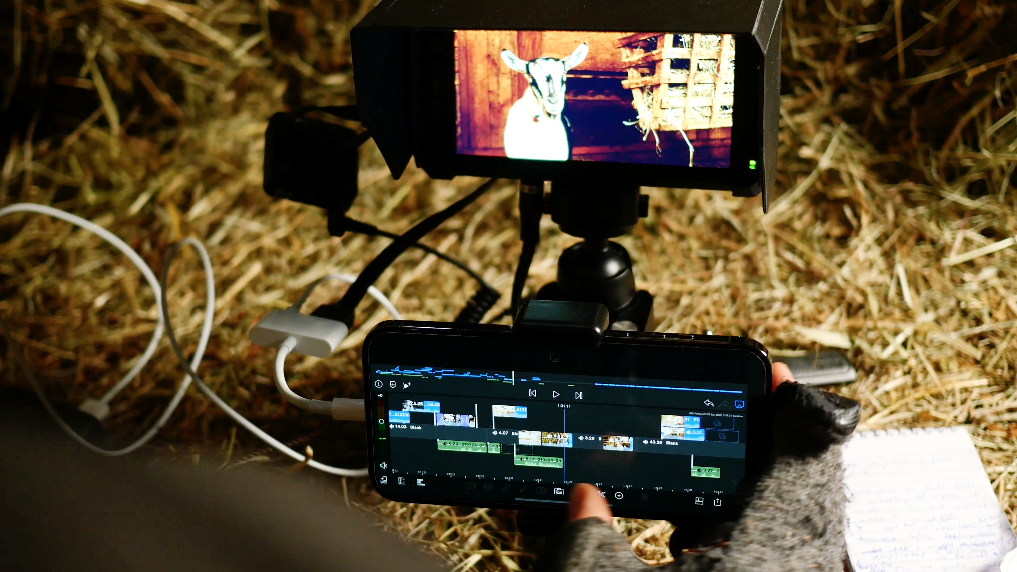EDITOR’S NOTE: This is the fourth in our five-part video series, "Field Testing," in which independent video producer Alexander Trowbridge retreats to a farm to learn the tools and skills necessary for anyone to make compelling visual stories when working alone in the field. Watch Episode 1 here. Watch Episode 2 here. Watch Episode 3 here. The last episode publishes next week!
As someone who’s had to edit many videos on the road, I’ve long been fascinated by what kind of post-production is possible on a phone. Editing apps like LumaFusion and the expanded processing power of newer mobile phones make the dream of practical field editing — of mixing your snippets into a story without having to leave the scene — all the more tangible. This combo of interest and equipment led me to push my fascination to the extreme this winter on the farm where I’ve been experimenting with various approaches to multimedia journalism.
I devised a challenge for myself: Edit a full news video at the location where it was filmed, using only the tools I could fit in a fanny pack. I found a story that illustrates an element of a larger system while still being based around a unique, defined location.
The story was about how the makeup of hay can affect the taste of cheese. (Who knew?) I filmed it in a barn where a neighbor runs a goat dairy. Instead of heading back to my cabin to edit the footage using my regular setup of a laptop, external monitor and the program Adobe Premiere, I retreated to the barn loft. I fashioned a desk out of hay bales and got to work with a system based around my phone.
I imported 4K footage from my camera and my drone using a card-reader adapter made for the iPhone (Lightning to SD Card Camera Reader: $29.) Apple has been making it easier to move and manage files on mobile devices. But the system isn’t perfect, especially, I discovered, for someone who shoots as much footage as I do.
I then assembled a series of portable components including a battery-powered monitor (Feelworld F6 5.7" HDMI On-Camera LED Monitor: $129), foldable keyboard (iClever BK03 Mini Foldable: $36.99) and collapsible mouse (Microsoft Arc Mouse: $79.99), into what I call the field editor. This setup is not absolutely necessary when editing video on your phone. But I was transitioning from traditional desktop editing, and felt more comfortable with a system that accommodated the habits I’d developed, like a heavy reliance on keyboard shortcuts. I justify the larger items as tools already useful on a documentary-style video shoot, like an external monitor. Such a monitor is normally paired with cameras to give you a clearer picture of what you’re filming. I’m able to attach it to my phone with an HDMI adapter (Lightning Digital AV Adapter: $49.00).
The linchpin of the whole setup is the LumaFusion app I mentioned above ($29.99), a multi-track video editing app that, among other things, lets me move the window I use to preview my footage off of my phone and onto the external monitor, freeing up valuable screen space for what’s called the timeline. And while I appreciate its compatibility with keyboard-based editing, the app is primarily a touch-based program. For newcomers, learning the helpful action-performing gestures can save as much time as I get out of keyboard shortcuts.
To focus the viewer’s eye with a bit of simple animation, I also used the mobile art app called Procreate Pocket ($4.99), which allows me to draw directly on to still shots from videos I’m producing.
What I learned from my night in the barn
I ended up pulling an all-nighter in the barn to edit the video above. It partially took so long because I was simultaneously trying to document the process for the "Field Testing" series. But it also took a long time because editing can take a long time, especially if one is still getting to know a new system. I’m proud of the video I was able to make, but it’s far from perfect — much like my method for getting it done.
And yet, for journalists who are curious about video editing, I would recommend mobile editing as a good entry point. It costs less. It’s less complicated. And you can do it from anywhere.
And forcing myself to edit my footage on the spot meant it wasn’t sitting for months on a hard drive, haunting me. So as a storyteller, I’m excited about knowing basic field editing skills. It means I can tell the story I want — even if I have to spend a night in a barn.
Watch episode five next: Final thoughts on video essentials, solo production and — of course — camera gear
***
Alexander Trowbridge is a multimedia journalist and producer. Most recently a fellow with the Nieman Foundation for Journalism at Harvard, he previously worked at "The Late Show With Stephen Colbert," Bloomberg Politics, CBS News and Politico.



